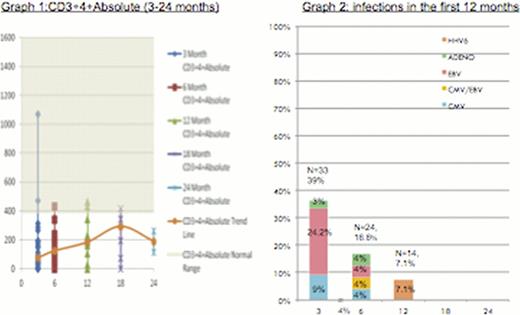Abstract
Abstract 1935
The success of allogeneic HSCT in the treatment of advanced MDS has been limited by high incidence of relapse and transplant-related mortality (TRM). The main complications contributing to TRM are graft-vs-host disease (GvHD) and infections. Although T cell depletion has successfully reduced the incidence of GvHD, slow immune reconstitution and high rate of infections have compromised its full potential. T cell reconstitution after transplant requires a functional thymic epithelium. Transplant conditioning regimens damage the thymus and impair the production de novo of T cells. Keratinocyte growth factor (KGF) has an important role in healing the epithelium after injury. Palifermin, a human recombinant form of KGF, decreases the incidence and duration of mucositis after total body irradiation and has been approved by the FDA for this purpose in autologous and allogeneic HSCT. In murine models, KGF given before allogeneic transplant has a protective effect on the thymus and accelerates T cell reconstitution.
The aim of this study was to assess whether administration of palifermin peri-transplant decreases TRM and improves the overall and disease-free survival (OS and DFS). This study was designed to reduce one- year TRM from 30% and 35% to 10% in HLA matched and mismatched arms, respectively.
Between 11/2009–05/2012, 42 patients (advanced MDS: 26 or AML evolved from MDS: 16) enrolled on this trial. At transplant, 23 were in CR1, 3 were in second refractory cytopenia phase, and 16 had limited disease (<5% circulating blasts and <9% marrow blasts). The median age was 57.5 years (1–65), with 22 males and 20 females. Conditioning consisted of busulfan (12 doses over three days of 0.8 mg/kg IV for patients > 4 years old or 1.0 mg/kg IV for patients < 4 years old), melphalan (70 mg/m2 IV × 2 days), fludarabine (25 mg/m2 IV × 5 days), and rabbit ATG pre-transplant (2 doses and 3 doses for HLA matched and mismatched recipients, respectively). Palifermin was given according to the approved dose for mucositis prevention: 60 mcg/kg/day IV for 3 consecutive days before the preparative regimen, and 3 doses post transplant (day 0, +24hours, +48hours). Donors were HLA matched (31; 13 related and 18 unrelated) or unrelated mismatched (11). G-CSF mobilized donor peripheral blood stem cells underwent CD34+ selection and depletion of T cells using CliniMACS immunomagnetic selection columns (Milteny Biotec).
All 42 patients engrafted, 1 patient developed secondary graft failure. The cumulative incidence of grade III-IV aGvHD at day +100 and 1 year were 4.8% and 10.5%, respectively.
The latter increase was due to late-onset acute GvHD. Only 1 of 33 patients at risk developed moderate chronic GvHD. The 2-year OS and DFS were 77% and 65%, respectively, and similar in the two arms (HLA matched and mismatched). The CI of relapse at 1-year was 12 % (similar in the two arms). The 1-year TRM was 20%; 18.4% in the HLA matched group (accrual met) and 22% in the mismatched arm (accrual ongoing). Causes of death were: infections (N=5; 3 HLA matched, 2 HLA mismatched), regimen related toxicity (N=2, liver VOD) and relapse (N=1). The frequency of infections was similar to historical controls; at 3 months post transplant, 30% of patients developed active CMV, EBV, or adenovirus infections, at 6 months 16.6%, and at 12 months 7.1%. The 6-month CI of CMV viremia in CMV seropositive patients was 75% and the 6-month CI of EBV viremia was 31%. Immune reconstitution as measured by CD4 count was slow, similar to historical controls, with median absolute CD4 count at 3 months of 77 cells/μl and 200 cells/μl by 1 year posttransplant. Other parameters to assess safety of this regimen, namely duration of narcotics use and days on TPN to measure severity of mucositis were similar to historical controls (same preparative regimen without palifermin).
In this ongoing phase II trial the addition of peri transplant palifermin to a chemotherapy only myeloablative conditioning regimen in recipients of TCD HSCT for advanced MDS decreased the TRM, although did not meet the primary objective of this study (reduction to 10%). Also, there was no reduction in the incidence of viral infections and no improvement in immune reconstitution. The reduction in TRM resulted from early detection of infection and improved treatment options.
Perales:SOBI Biovitrum, pharma company: SOBI Biovitrum, pharma company Other. Goldberg:SOBI Biovitrum: Research Funding.
Author notes
Asterisk with author names denotes non-ASH members.


